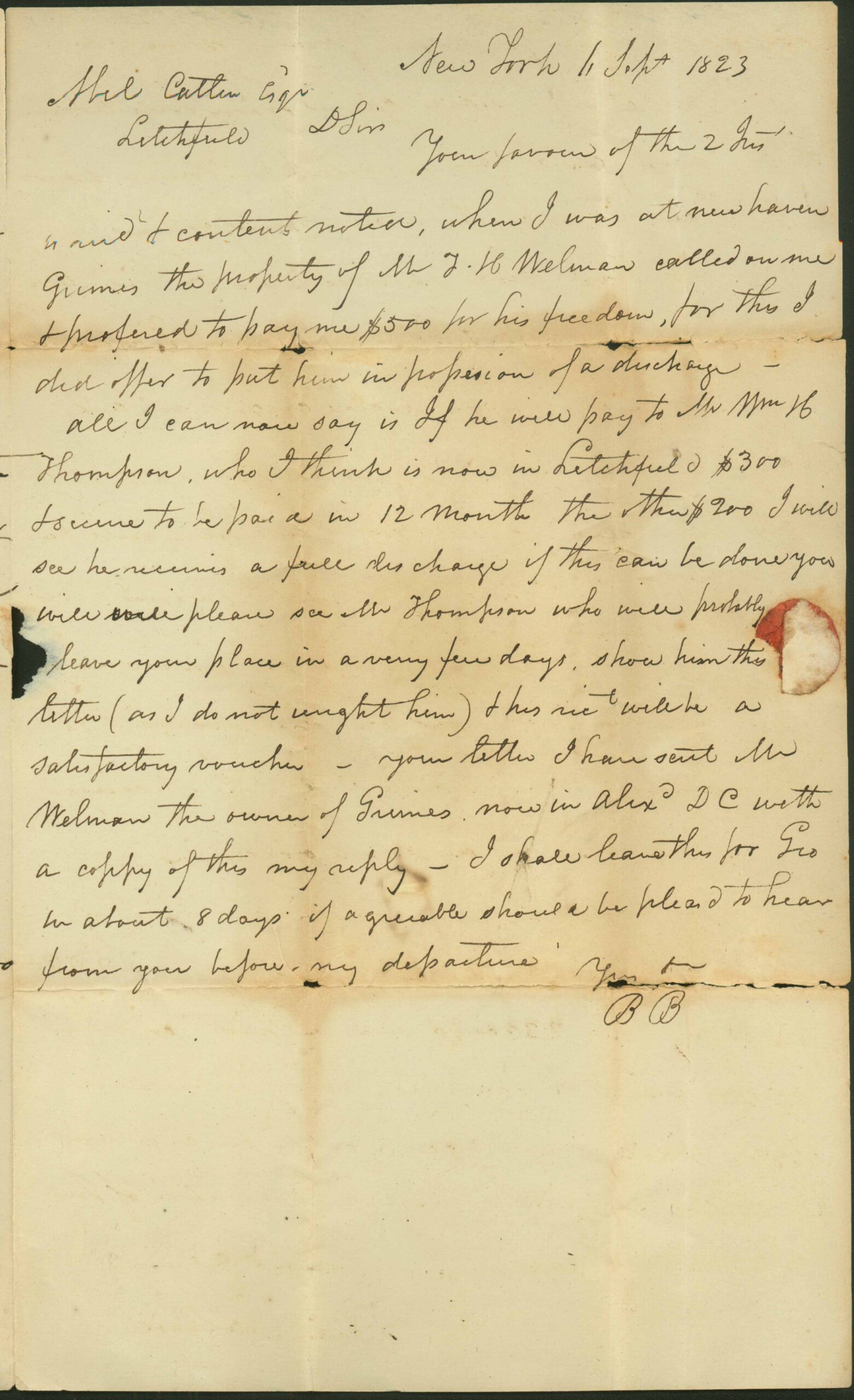Kate Zullo
Litchfield Historical Society
TEACHER'S SNAPSHOT
Subjects:
African Americans, Law, Literature, Race, Slavery & Abolition
Course Topics/Big Ideas:
Civil Unrest, Civil War, and Reconstruction, Expansion, Influence, and Economic Growth, Origins of United States Democracy and National Identity
Town:
Litchfield, New Haven
Grade:
Grade 8
Lesson Plan Notes
William Grimes was born into slavery in 1784 in Virginia and was enslaved by at least ten different masters during the first thirty years of his life. In 1814, he escaped by hiding on a ship bound for New York and settled in Connecticut, where he faced discrimination and the constant threat of discovery and a return to enslavement. When he was recognized by a friend of his former enslaver, Grimes was forced to sacrifice all he had earned to buy his freedom. To earn money, Grimes wrote Life of William Grimes, the Runaway Slave: the first book written by a freedom seeker of slavery in America. At a time before the abolition movement was well known, Grimes used his unapologetic voice to argue against the institution of slavery while revealing a complexity of emotions for all he endured.
ESSENTIAL QUESTION
SUPPORTING QUESTIONS
- How does Grimes’s story help us understand Connecticut’s role in the system of slavery?
- How did federal and state laws, such as Connecticut’s Gradual Emancipation Act of 1784 and the Fugitive Slave Act of 1793, impact the lives of enslaved people like William Grimes?
- In what ways does Grimes’s autobiography challenge attitudes about slavery and freedom in northern and southern states?
- Why is it important for people such as William Grimes to tell their own story?
ACTIVITY
- Introduce students to William Grimes, the author of Life of William Grimes, the Runaway Slave. Students will read the opening passage of Grimes’s narrative in which he introduces himself to the readers. After reading the opening, students will compose a list of questions they have about Grimes and his life.
- To better understand the historical context of Grimes’s life, provide an overview of the history of slavery in Connecticut, showing them the Acts and Laws of the State of Connecticut in America (1784). Have the class read the excerpt from the Fugitive Slave Act of 1793 and discuss the following questions:
- What powers were given to slaveholders and their agents under this law?
- How would laws like the Fugitive Slave Act affect someone like Grimes, who had escaped slavery and had built a life in Connecticut?
- How would these laws impact free black residents of Connecticut?
- Working in pairs or small groups, assign each group one quote from Grimes’s narrative. Have students first read their quote and then answer the questions provided. They will discuss their thoughts with their partner or small group before sharing them with the class. After all the groups have shared, facilitate a class-wide discussion that explores the tone, content, and impact of Grimes’s narrative.
- Distribute reproductions of the letters between Abel Catlin and the Burrows so that each group has a copy of both letters. Encourage students to read what they can of the content, giving them time to carefully observe the documents and make notes of their physical characteristics, such as handwriting style.
- After giving students time to examine the reproduction of the letters, provide students with the transcriptions and Letter Analysis Tool to guide their reading and study of the letters. Start with the letters from Abel Catlin to Joseph Burrows and then the reply from B.B. (possibly Benjamin Burrows, Joseph Burrows’s brother). Alternatively, groups can use the Library of Congress Primary Source Analysis Tool as a guide.
- Bring the class together to discuss what they learned from the letters, guided by the following questions:
- What did it cost Grimes to purchase his freedom?
- How did the language and tone of the letters compare?
- What might that reveal about Catlin and Burrows’s perspectives?
- What can we learn about William Grimes’s experience as a freedom seeker from these letters?
OPPORTUNITIES FOR ASSESSMENT
Assessment Option 1: Letter
After Grimes published the first edition of his autobiography in 1825, he sent a copy to then President John Quincy Adams with the inscription, “Relying on your Excellency’s generosity, the Author presents this pamphlet to the President of the United States, Stamford, CT; May 15, 1826, Wm. Grimes.” (Boston Atheneum) Have students choose a historical figure who was a contemporary of Grimes: a politician, such as President John Quincy Adams or Chief Justice John Marshall; a literary figure, such as Harriet Beecher Stowe or Frederick Douglass; or a reformer, such as Horace Mann or Prudence Crandall. Imagining themselves in that era, have students write a letter to that historical figure telling them about Life of William Grimes and its author, incorporating both their knowledge of Grimes’s life and that of the historical figure.
Assessment Option 2: Compare/Contrast
Grimes wrote his narrative in 1825, before the abolition movement reached mainstream audiences. Have students compare and contrast Grimes’s narrative with the writings of later freedom seekers, such as Frederick Douglass’s 1845 Narrative of the Life of Frederick Douglass: an American Slave or Harriet Jacobs’s 1861 Incidents in the Life of a Slave Girl.
Assessment Option 3: Questions
Grimes’s narrative is powerful because it was written down and preserved. However, countless other stories of freedom seekers were never recorded. Students will reflect on whose stories are remembered and whose experiences were never documented in the historical record. Have students create a list of questions about the lives of freedom seekers that were not recorded.
RESOURCE TOOL KIT
Excerpts from Life of William Grimes, the Runaway Slave and the Fugitive Slave Act of 1793
This document also contains Comprehension and Critical Thinking questions for students.

Abel Catlin letter at the Litchfield Historical Society’s Helga J. Ingraham Memorial Library
Catlin, Abel to Burrows, Joseph, 1823 Sep 2
Dr. Abel Catlin makes an argument to persuade the owners of William Grimes, an enslaved man who escaped from his owner in Savannah, GA, to allow Grimes to purchase his freedom.

B.B. letter at the Litchfield Historical Society’s Helga J. Ingraham Memorial Library
B.B. to Catlin, Abel, 1823 Sep 11
B.B. (possibly Benjamin Burrows, Joseph Burrows’s brother) notifies Catlin that he met with William Grimes in New Haven and is willing to accept a payment of $300 followed by an additional sum of $200, at which time he will give Grimes his “discharge papers.” He gives instructions for payment and correspondence to be sent through William H. Thompson. This letter is written on the back of the letter sent from Abel Catlin to Joseph Burrows.
Transcriptions of Abel Catlin letter and B.B. letter
Letter Analysis Tool
ADDITIONAL RESOURCES
Places to GO
Take part in Litchfield Historical Society’s “Slavery Here: The Life of William Grimes” walking tour.
Visit New Haven’s Grove Street Cemetery, where Grimes is interred, and other sites on the CT Freedom Trail.
Things To DO
Show your students Gina’s Journey: The Search for William Grimes, which follows Regina Mason, William Grimes’s great-great-great-granddaughter, as she uncovers his story.
While designed for grades 3 and 4, older students can learn more about William Grimes’s New Haven through various historical maps featured in the Teach It “William Grimes: Seeking Freedom in Connecticut.”
Websites to VISIT
Read the entry for William Grimes in the Litchfield Historical Society Ledger.
Watch the recorded lecture “Mondays at Beinecke: Life of William Grimes with Regina Mason.”
Browse the “North American Slave Narratives” collection from the digital publishing initiative Documenting the American South at the University of North Carolina at Chapel Hill. (language updated 2021)
Articles to READ
“Gradual Emancipation Reflected the Struggle of Some to Envision Black Freedom” by Peter P. Hinks. ConnecticutHistory.org, Apr. 2014.
“Jackson v. Bulloch and the End of Slavery in Connecticut” by Andy Piascik. ConnecticutHistory.org, Feb. 2021.
“Venture Smith, from Slavery to Freedom” by John Wood Sweet. ConnecticutHistory.org, Sept. 2014.
“Rediscovering William Grimes, the Runaway Slave” by Regina Mason. Connecticut Explored, Winter 2021/2022.
“The Slave Narratives: A Genre and a Source” by David W. Blight. The Gilder Lehrman Institute of American History. History Now: Primary Sources on Slavery, Winter 2004.



